Page 1 Daily News
by Gail Helmer
Friday, March 16, 2001
Military News
Italy to Acquire USAF F-16s.
On March 15, Italy signed an agreement for the lease of 34 F-16s from the U.S. Air Force inventory and a Letter of Offer and Acceptance (LOA) for aircraft support and services. The F-16s will replace the Tornado Air Defense Version aircraft currently leased from the United Kingdom and the F-104s, both operated in the air defense role. The first F-16s will be delivered in mid-2003. The five-year lease is renewable for a second five-year period. The LOA and lease value is approximately $777 million over 10 years.
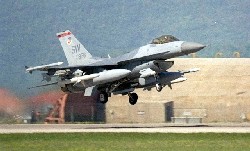
The F-16 aircraft are currently in storage at the Aerospace Maintenance and Regeneration Center in Tucson, Ariz. Before delivery to the Italian Air Force, all of the flying aircraft will be refurbished and brought up to date with all required inspections and changes. At the same time, the aircraft will receive the Falcon UP structural upgrade. The F100-PW-200 engines will be upgraded to the F-100-PW-220E configuration to improve operability, reliability, maintainability, durability, safety, and operation and support costs.
Italy will be the 21st country to operate the F-16 Fighting Falcon. They are the sixth country to acquire F-16s from the USAF inventory and are the second country to use the lease approach. Several countries in Central Europe are considering lease/purchase of inventory F-16s as the fastest and lowest-cost option for acquiring Western-built fighters to upgrade their air forces.
The F-16, the world's most sought-after fighter, is the choice of 22 countries, counting the announcements of Italy and Chile. More than 4,000 aircraft have been delivered; hundreds more will be delivered to Egypt, the United States, Israel, Greece, the United Arab Emirates, Korea and Singapore; and production is expected to continue beyond 2010. Major upgrades for all F-16 versions are being incorporated to keep the fleet modern and fully supportable over the aircraft's long service life.(USAF Photo)
Two South Africa Firms Awarded Major Gripen Contracts.
Saab and BAE SYSTEMS have awarded two contracts for the Gripen fourth-generation fighter to South African firms. These are part of the Defence-related Industrial Participation (DIP) contracts required by the South African government as part of the major arms deal signed last year. Saab and BAE SYSTEMS have already placed contracts with South African companies worth more than US$800-million (or 55 per cent of the total DIP obligation) over the period to April 2007.
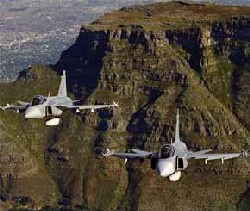
Denel Aviation has been awarded a US$3.6-million (approximately ZAR28 million) workshare package to manufacture a section of the Gripen centre fuselage for the Swedish Air Force's next batch of Gripen advanced fighters. Denel will also produce additional fuselage sections for the 28 Gripen swing-role fighters ordered for the South African Air Force. The work package gives Denel Aviation the option to produce 100 fuselage units of which the initial Saab order (for the Swedish Air Force) is for 40 units. These will be built at Denel Aviation's facilities at Kempton Park, near Johannesburg. The sections will also be incorporated into all future export order Gripen aircraft.
The fuselage section is technically known as the Main Landing Gear Unit (MLGU) because it is the main lower central fuselage section housing the main undercarriage and complex fuel, electrical and hydraulics systems. The MLGU represents one of the largest portions of the fuselage, requiring advanced precision engineering and manufacturing processes.
South African high technology company Grintek Electronics Systems has been selected to supply communications units for the Gripen The US$4.3-million order requires Grintek to supply units for incorporation into the Gripen's audio management system. This order specifically covers the manufacture, delivery and installation of the units for Swedish Air Force Gripen fighters to be delivered from 2002 onwards. Grintek's contract follows a previous order it secured in October 1998 for the development and delivery of Audio Management System prototypes. The international export version of Gripen will be equipped with an Audio Management System based on Grintek's GUS 1000 system which was developed in South Africa.
The MLGU work package forms part of the ZAR3.5-billion umbrella agreement signed in March 2000 with Denel Aviation which covers other manufacturing work on Gripen, Hawk, the Avro RJ/RJX jetliner and Airbus. Much of the Gripen work placed with Denel Aviation has been made possible through the skills and high-technology transfer programmes initiated by Saab and BAE SYSTEMS. The first group of South African engineers, technicians, systems specialists, pilots and logistical support officers from Denel and the SA Air Force has already been transferred to Sweden. They are based at Saab in Linkoping where they are training on and becoming familiar with the industrial processes, technology and systems used in the production and operational support of Gripen.
In addition, a fully equipped computer aided design/computer aided manufacturing design centre has been established at Denel Aviation by Saab. Denel Aviation uses these facilities in component design work for Gripen and Hawk, but can also generate additional revenue by using the system for work on other aircraft and components.(Saab Photo)
GKN Composites Top Titanium For RAH-66 Component.
A programme intended to show off GKN Aerospace's rapid creation of manufacturing tools proved so successful it resulted in a significant modification to a critical component of the RAH-66 Comanche helicopter. As part of its demonstration to Sikorsky, GKN and Sikorsky engineers selected the transmission support fitting of the Comanche. This highly contoured, complex fitting, which attaches the helicopter's main rotor system to the aircraft, normally is made of titanium.
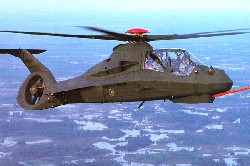
GKN manufactured four of the fittings using its unique advanced resin transfer moulding process (AdvRTM). The quality of the parts resulting from the rapid prototype tooling demonstration was so impressive, Sikorsky ordered a fifth to test its structural capabilities. This composite part exceeded 140% of normal performance in pitch, roll, thrust and torque testing, matching the performance of the titanium design.
The composite part is expected to cost less than its titanium equivalent. However, it also weighs 30% less, 53 pounds as opposed to 85 pounds. Those savings are vital because of the relationship of weight to aircraft performance, payload and affordability. Based upon GKN's success with this fitting, GKN and Sikorsky now are now exploring the possibility of replacing other Comanche titanium components with GKN composites.
"We have known, for many years, that our composites are ideal for replacing titanium in many critical aircraft components. It is very exciting that a demonstration of our tooling capabilities allowed Sikorsky to see first hand that composites offer a wide range of possibilities for aircraft designers seeking to cut weight and cost,'' said Tony Cacace, Chief Executive Officer of GKN Aerospace, a division of GKN plc.
The RAH-66 Comanche Helicopter is being designed for the US Army as a joint venture of Sikorsky and Boeing. Thirteen aircraft are scheduled for production beginning in the third quarter of 2002 under the Engineering, Manufacturing and Development (EMD) phase of the project. Boeing and Sikorsky will use five for testing and the Army will use eight for training and testing. After the EMD phase, regular production calls for the manufacture of 1,205 helicopters over next 25 years.
GKN has begun production of a sixth fitting for fatigue testing. In the first quarter of 2001, the company expects to submit a proposal to build 13 fittings under the EMD phase of the Comanche program.
Training Accident Investigators Arrive in Kuwait.
A DoD investigation board arrived in Kuwait March 15 to determine the cause of a training accident that killed six coalition service members and injured seven others. Central Command has asked the board to finish their work no later than April 16, Pentagon spokesman Rear Adm. Craig Quigley told reporters here. Marine Corps Lt. Gen. Mike DeLong heads the investigating team, made up of one member each from the Air Force and the Navy and two from the Army. New Zealand and Kuwait accepted DoD's invitation to contribute advisory members and observers.
Each of the services will also conduct safety investigations, Quigley said. While the investigation board works to ascertain the accident's cause and glean lessons learned, safety investigators would look at specific safety issues rather than hardware or equipment problems, he noted. "Gen. DeLong's efforts on the ground in Kuwait will make sure the safety investigations are deconflicted from his own team's work so that both objectives are met," Quigley said. DeLong's report will include the board's findings, recommendations and any possible follow-on legal actions, Quigley said.
At this point, he stressed, it's too early to try to assign blame or speculate on an overarching cause of the accident. DeLong has a "broad charter to learn all the details he can that will shed light on how this tragic accident occurred," Quigley said.
Synopsis Of Al Udairi Range Accident.
The following synopsis of the March 12 training accident at the Al Udairi Range in Kuwait is based on a U.S. Central Command review of initial reports from the scene. The Udairi Range is a training facility located about 45 miles northwest of Kuwait City. It is 20 kilometers by 27 kilometers in size. It is regularly used by coalition forces for training exercises involving both live and inert ordnance, including close air support exercises, or CASEX.
CASEX are held quarterly for the purpose of practicing air operations against hostile ground targets in close proximity to friendly forces. The exercises involve friendly ground and airborne forces directing friendly fighter aircraft on attacks on simulated enemy targets.
Four observation posts on the Al Udairi Range are used to control exercises. Observation Post 10, the accident location, is the only post that controls live-fire events. Various targets, including tanks and tactical vehicles, are located randomly in impact areas throughout the range. Besides CASEX, the range is used for other live-fire exercises.
The March 12 CASEX began at 1 p.m. local time, and was scheduled for completion at 9 p.m. Aircraft from the United States, United Kingdom and Kuwaiti participated in the exercise. For the nighttime portion of the exercise, however, only U.S. aircraft were involved.
The CASEX included a ground forward air controller whose responsibilities included controlling the aircraft and providing close air support training to U.S. and Kuwaiti military personnel. He was also responsible for assisting the pilots in their missions and directing them to targets located more than two kilometers away from Observation Post 10.
During the mission, about 20 coalition military personnel were in the vicinity of Observation Post 10, including Americans, Kuwaitis and the New Zealand liaison officer assigned to the Combined Joint Task Force in Kuwait.
The accident occurred just after 7 p.m. local time. An F/A-18C Hornet from Strike Fighter Squadron 37, operating from the USS Harry S Truman in the Northern Arabian Gulf, was under the control of the ground forward air controller at Observation Post 10. Three Mk-82 500-pound bombs were released. Initial reports indicate the center of the bomb impact pattern was approximately 90 feet from the observation post. The ground forward air controller was among those injured.
The pilot was Navy Cmdr. Dave Zimmerman. The ground forward air controller was U.S. Air Force Staff Sgt. Timothy Crusing.
While various media reports have addressed the actions of the ground forward air controller and pilot, the specific details of those actions have not been established and will be a focus of the investigation.
Immediate medical assistance was requested from the scene. U.S. military helicopters with medical personnel responded to the scene and evacuated injured personnel to Kuwait Armed Forces Hospital in Kuwait City. Following the medical evacuations, the site was secured.
Five U.S. military personnel were injured, four from the Army and one from the Air Force. Two soldiers were treated at Camp Doha and released. Three servicemembers were admitted to the Kuwait Armed Forces Hospital. One of them was transported to Landstuhl Regional Medical Center in Germany on March 13. The other two were transported to Landstuhl via a C-17 Globemaster III transport aircraft March 14.
US GAO Slates F-22 Flight Testing Delays.
In a report issued yesterday the US GAO said the US Air Force was "...significantly behind in flight-testing, due to continuing assembly and manufacturing delays, and it is behind schedule in completing non-flying tests that assess the structural integrity of the aircraft." According to the GAO the delays meant that the Air Force would have to extend the test programme past the planned completion date or proceed to the next stages of the program without completing all flight-tests. In addition the programme was not likely to remain within the congressional mandated budget.
The report pointed out that Director, Operational Test and Evaluation had also indicated that operational testing, could not be started as scheduled without clearly unacceptable risks and would probably be delayed almost a year. Because the Air Force was unlikely to complete F-22 development within the current cost limitation, the GAO recommended that the Air Force, in order to reduce '...risks and preclude manufacture and delivery of F-22 aircraft that have not been fully tested, limit low-rate initial production to no more than 10 aircraft a year until initial operational test and evaluation is completed."
Rangers Adopt Tan Beret.
The Army's elite Rangers will wear tan berets in the near future, a move that resolves a bitter dispute sparked when the Army announced in October that all units of the Army would begin wearing black berets June 14, 2001. Army Chief of Staff Gen. Eric K. Shinseki approved the regiment's request to change its beret to maintain the distinctiveness of the unit and reflect the legacy of Ranger history.
The Rangers studied several options, officials said, before deciding on the Ranger Tan Beret. The change was requested by a memorandum from Col. P.K. Keen, regimental commander, in a memorandum dated March 9, 2001, to the Army chief of staff. "The black beret has served the Rangers well and will be a symbol of excellence and unity for the Army," Keen said.
Keen said changing to the tan beret for Rangers is not about being different from the rest of the Army, but about a critical aspect that unifies the Army - high standards. "The decision to adopt the Ranger Tan Beret is based upon maintaining a distinctive beret for our Rangers as the Army transitions to the black beret," Keen said. Keen said the Rangers support the Army's decision to don the black Beret and view this as another step forward in the overall Transformation of the Army.
Tan is the one universal and unifying color that transcends all Ranger operations, officials said. It is reminiscent of the numerous beach assaults in the European Theater and the jungle fighting in the Pacific Theater of World War II, where Rangers and Marauders spearheaded victory. Tan represents the khaki uniforms worn by Korean and Vietnam War era Rangers, officials said. It is the color of the sand in Grenada, Panama, Iraq, and Mogadishu, where modern-day Rangers fought, died and continued to Lead the Way, they said.
Thursday, March 15, 2001
PC News
Air Command 3 Goes Gold.
Shrapnel Games announced today that Air Command 3 has gone gold and will be shipping by April 1st. With the assistance of an actual Air Traffic Controller, Developer Joe Jaworski has balanced game play and realism to give the gamer a feel of what it is like to direct air traffic at a major international airport. Multiple difficulty levels, pilot digitized voices, and an airport editor provide for many hours of nail biting game play. Added to the final release are pilot miscommunications and errors. For more information go to: Shrapnel Games
Bankruptcy for Karna?
Kärna -- the parent corporation of Razer, is reported to be on the brink of bankruptcy. According to online reports that quote Razer’s general manager, one of Kärna’s large investors has pulled their capital. The creators of the Boomslang mouse are in discussions with other investors and are optimistic that a new investor will be secured soon.
Warbirds III Limited Open Beta.
Warbirds announces Warbirds III open beta. According to Jay Littman, Executive Producer, the primary purpose of the initial open beta test is to expand the numbers playing WarBirds III, which will help identify problems in the software, which they will then be able to fix. The Open Beta arena is a play at your own risk area, and is open to everyone in the WarBirds and Dawn of Aces community. Warbirds
New Linux driver from NVIDIA.
The release of 0.9-767 drivers for Linux continues to add more support for our Linux drivers by continuing to revise TwinView(tm) support and fix existing problems in our drivers. The NVIDIA Linux OpenGL support continues to be the industry's most robust implementation available. Check out the website at: Nvidia
Military News
2,938 Fighters Will Be Built between 2001-2010.
A total of 2,938 combat aircraft valued at $134.4 billion (in 2001 US dollars) will be built worldwide in the 2001-2010 period, predicts Teal Group in their latest world fighter/attack aircraft production forecast released today. The new Teal forecast covers all combat aircraft over 20,000 lbs maximum take-off weight (all supersonic planes plus the AV-8B Harrier).
The numbers indicate that the market is at its lowest point since the jet age began. A mere 153 fighters worth $6.7 billion will be delivered this year. "Hopefully, procurement holidays have created a market trough; the alternative to that explanation—a permanent sub-$10 billion annual market—is too unfortunate to contemplate" said Richard Aboulafia, lead analyst for Teal Group’s "World Military and Civil Aircraft Briefing," the 1,400-page monthly-updated competitive intelligence service, in which this and nine other consolidated forecasts plus 156 separate aircraft program reports are published and regularly updated.
The future of the market is clouded with doubt and uncertainty. However, Teal Group predicts a fairly robust recovery, as procurement holidays end in the US and Europe. "After several false starts, the market will turn healthy again before the second half of our forecast period," said Aboulafia. "The annual value of fighter production will double by 2006." Because Europe’s procurement holiday was longer, Europe’s market share will increase dramatically, as Eurofighter and Rafale series production begins.
The biggest question hanging over the fighter market is the future of the US programs, particularly the Joint Strike Fighter (JSF). If no action is taken, the long-anticipated budgetary train wreck will result in the death of JSF, with dire consequences for US industry, and America’s status as a superpower. "Fighter exports are more than just a source of cash; they guarantee that international customers become clients of what might be termed the US defense operating system," notes Aboulafia.
To preserve JSF and US industry, Teal Group recommends that the F-22 and F/A-18E/F acquisition programs be truncated to 216 and 420 aircraft, respectively. Despite the drawbacks of implementing this program, it will allow JSF to proceed after a delay of only about two years, with no major increase over the current level of fighter procurement funding.
To accomplish this, the services must work with Congress to guarantee the survival of current programs, especially the F-22. Congress must realize that cutting these programs further will increase unit costs. Industry must continue to work to reduce production costs, making JSF and the current planes look like financially attractive options.
Beyond 2010, the future belongs to JSF. "Assuming this program goes ahead, JSF will allow US industry and its international allies to dominate the fighter market after 2015," said Aboulafia. "To avoid this fate, Europe’s fighter makers must join forces, either with each other or with US partners. But if JSF is delayed or killed, the US will be at a severe disadvantage after 2010."
Teal Group Corporation is a defense and aerospace consulting firm providing competitive market intelligence to industry and government.
U.S. Provides Data To Russians For Mir Splashdown.
United States space specialists are providing Russian technicians with Mir space station positional data to help ensure the vehicle's safe splashdown in the Pacific Ocean later this month. Officials from U.S. Space Command at Peterson Air Force Base, Colo., are now providing the tracking information through the National Aeronautics and Space Administration to Russia's aviation and space agency -- RosAviaKosmos -- in Moscow, said USSPACECOM spokesman Maj. Perry Nouis. "We have an observer role limited to providing data to the Russians," Nouis said. "This is actually routine for us. We've been tracking Mir since it was launched in 1986."
Mir is one of 8,300 orbiting objects USSPACECOM tracks daily to provide space situational awareness and warning against possible incoming ballistic missiles, he said. The Russians have said Mir's controlled re-entry is strictly their responsibility, Nouis said. Unusual to the operation, though, "is the amount of data and the frequency of updates USSPACECOM is providing the Russians --several times a day." As Mir gets closer to splashdown -- now estimated to occur between March 17 and 20 somewhere in the South Pacific between New Zealand and South America -- the United States plans to provide hourly updates, he said. "We're just one source of information for them," Nouis said "The European Space Agency is also providing Mir tracking information to the Russians."
The former Soviet Union launched Mir's main module into orbit Feb. 20, 1986, Nouis said. After gathering scientific data for more than a decade, the 140-ton space station -- with several modules each the size of a school bus -- has reached the end of its useful life, he said. For years, Nouis said, NASA astronauts and Russian cosmonauts have worked together on various projects aboard Mir. Controlled re-entries of old spacecraft are not anything new for the Russians. They have "directed successful splashdowns of many other units," Nouis said.
The U.S. government has agreed, within its capabilities, to provide Russia with Mir tracking and trajectory data, as well as scientific data on atmospheric conditions, including solar activity, during the de-orbit period, according to a March 2 U.S. State Department news release. USSPACECOM uses its Space Surveillance Network's ground-based radar sensors and telescopes at 19 locations around the world to track the Mir and other objects, Nouis said. The Russians will incorporate U.S.- and European-supplied Mir data with their own. More than 26,000 items have been shot into Earth's orbit since the Russians launched Sputnik in 1957, Nouis said. More than 17,000 have re-entered the atmosphere since then, he said, with most splashing down in the oceans or disintegrating from friction. Mir is so large, he said, that scientists around the world estimate about 25 tons of it could survive the return to earth. "There is lots of uninhabited ocean between New Zealand and South America in the Mir target area," Nouis said. Oceans cover 75 percent of Earth's surface.
Wednesday, March 14, 2001
PC News
.
GAMESTOCK 2001: Flight Simulator 2002.
Microsoft® Flight Simulator 2002 Professional Edition is a new version of Microsoft's highly realistic aviation simulation. Flight Simulator 2002 introduces many exciting features, visible rivets, treaded tires, and even some signs of wear and tear. The game will let you pilot a number of different planes including a Learjet, a Cessna 172S Skyhawk, a Boeing 737-800, and the mighty Boeing 747-400. Of course, the game is completely open-ended, so enthusiasts will be able to model and import their favorite civil, commercial, and military aircraft into Flight Simulator 2002. Release Date: Fall 2001.
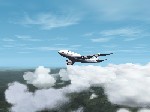
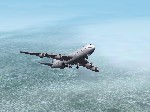
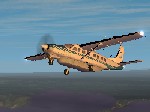
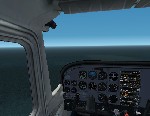
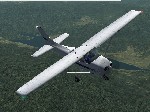
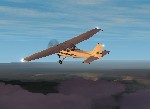
Flight Simulator 2002 Features:
GAMESTOCK 2001: MechCommander 2.
MechCommander 2 offers players a real-time game of power, combat and treachery set in the BattleTech® Universe. Players must use their strategic knowledge and tactical skills to change the balance of power in a region of space known as the Chaos March. Packing the heat of up to 16 MechWarriors, each capable of wielding up to 100 tons of "Mechanized" death, the MechCommander rules the battlefield from above, imposing his strategic will and mastering all he surveys. Release date: July 2001.
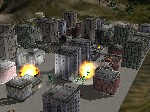
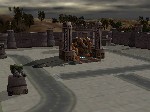
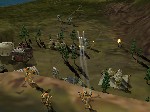
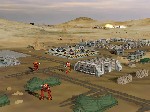

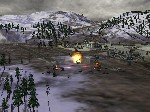
MechCommander 2 Features:
Activision Announces Star Trek Armada II.
Activision today announces Star Trek: Armada II for the PC. The game is being developed for Activision by Mad Doc Software, a new studio comprised of former employees from Looking Glass Studios and members of the Star Trek: Armada production team from Activision.
Set in The Next Generation universe, Star Trek: Armada II's story unfolds through three separate single-player campaigns played as the Federation, Klingons and Borg. Through 27 action packed-missions, players battle against the Cardassians, Romulans, Borg and Species 8472, each with it's own distinct play style, weapons, ships and base facilities.
Star Trek: Armada II adds a number of new strategic options and enhancements to Armada's winning gameplay mix. Maps in Star Trek: Armada II now have 3-D depth, and have been increased in overall size. To make optimum use of the added dimension, the game offers players a new Tactical View in which the battle unfolds in true 3D. Ships can also be placed into 3D formations for different firepower configurations, and to further immerse the player in the action. Damage modeling has also been revised for Star Trek: Armada II. In true Star Trek fashion, player's weapons can now damage different locations and sub-systems on targeted ships.
Star Trek: Armada II features an extensive range of multiplayer options, including up-to-eight-player competitions over LAN and the Internet where gamers can play as the Federation, Klingons, Borg, Cardassians, Romulans or Species 8472. Several additional multiplayer game types will also be available including variations of Capture-the-Flag, King of The Hill, and Co-Op style gameplay.
Star Trek: Armada II is expected to be available in the winter of 2001.
AMD, Linux NetworX Deliver Linux Supercluster to Boeing
AMD announced today that The Boeing Company has implemented an AMD Athlon processor-based supercluster developed by Linux NetworX. The high performance cluster system, featuring 96 AMD Athlon(tm) processors, is running computational fluid dynamics applications in support of the Boeing Delta IV Evolved Expendable Launch Vehicle program at the company's Space & Communications division in Huntington Beach, Calif. Boeing Delta IV engineers tested several other processor platforms at Linux NetworX facilities before purchasing the AMD Athlon processor-based cluster. The Delta IV is the newest class of rockets developed by Boeing that will enter service in 2002 and will have the capability of lifting satellite payloads of up to 29,000 pounds into geosynchronous transfer orbit.
Elsa Reports Record Revenue Growth Fiscal Year 2000.
Revenue growth of 58% to EUR 361 million exceeds market growth rates, positive group results of EUR 1.2 million confirm turnaround in earnings
Aachen, March 14, 2001 - ELSA AG, (WKN 507 360), leading supplier of Internet Access and Computer Graphics solutions, today announced results for fiscal year 2000. With an increase in revenue of 58% from EUR 228 million to EUR 361 million, the Company continued its growth trend and grew at a significantly higher rate than the competition. In accordance with US-GAAP, EUR 21.2 million of sales from the discontinued "OEM Workstation Graphics" business (1999: EUR 3.7 million) are not included in reported revenue.
With an increase in consolidated net income of EUR 5.6 million to EUR 1.2 million from the previous year's losses of EUR -4.4 million, ELSA reached its fiscal goal of positive earnings for 2000 as well.
As previously announced, the full annual report will be released on Friday, March 16.
MadOnion.Com Releases 3DMark™2001
MadOnion.com has released the first 3D benchmark that supports DirectX®8, featuring new playable game demo. Combining DirectX 8 support with the latest in 3D graphics, 3DMark2001 objectively measures how effectively a PC runs 3D graphics applications and provides users with benchmark results that allow them to make informed hardware assessments and upgrades. 3DMark2001 is available for free public download from MadOnion.com
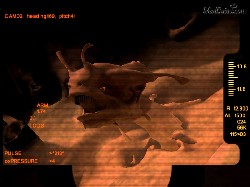
"Since the release of the first version of 3DMark in 1998, we've been continually striving to improve our benchmarks to help gamers from around the world maximize their experiences and PC performance," said Nathan Harley, Vice President, Marketing, MadOnion.com.
Important New Features of 3DMark2001:
Death From Above: World War I Arcade Dogfighting on Shockwave.com
The Groove Alliance, the next-generation entertainment and technology development company, today announced the launch of Death From Above: World War I Arcade Dogfighting, a 3D, browser-based, aerial dogfighting action and flight simulator game, on AtomShockwave's award-winning interactive and gaming Web site. Death From Above: World War I Arcade Dogfighting places players at the flight stick of WWI fighter planes and engages them in perilous dogfight-style combat.
Death From Above: World War I Arcade Dogfighting sets players above France in 1914 during the dawn of air-to-air combat. The player chooses from four different planes, each representing a different nation. Virtual pilots fly their planes to victory as they earn medals with each completed mission. High-resolution terrain and beautiful surroundings make for a great gameplay experience. Check it out at: Death From Above
Military News
Raytheon Awarded U.S. Navy AEGIS Contract.
The U.S. Navy has ordered additional AEGIS Weapons Systems equipment from Raytheon Company valued at $86.1 million for the DDG-51 Arleigh Burke Class Guided Missile Destroyer Program. The contract authorizes the manufacture, test, delivery and integration of SPY-1D (V) transmitters and Mark 99 fire control equipment and represents the fourth procurement of the newest AEGIS equipment variant. The equipment will be installed on Arleigh Burke class destroyers DDG-99, DDG-100 and DDG 101, the 48th, 49th and 50th vessels in that class.
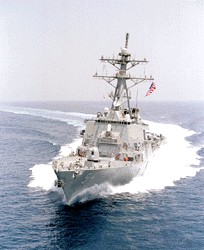
Prior to building radar equipment for the Arleigh Burke destroyers, Raytheon supplied the Navy with similar equipment to support the 27 Ticonderoga class AEGIS Cruisers currently in the Fleet. "The award represents the continuation of our 22-year involvement with this important Navy program that protects our forces at sea," noted Dan Smith, Raytheon's Naval & Maritime Integrated Systems (N&MIS) vice president and general manager. The work is to be performed at Raytheon's Andover and Sudbury, Mass., facilities and is expected to be complete by November 2003.
Raytheon To Supply Navigation System For Type 45 Destroyer.
Raytheon Systems Limited (RSL) has been selected as the supplier for the Navigation System and major components of the Integrated Bridge for the Royal Navy's new Type 45 Destroyer. The contract is valued at around GBP12 million and will cover the first three ships of the type and the PAAMS Trials Vessel. RSL, supported by Raytheon Marine GmbH at Kiel and SML Technologies, will be providing the navigation radars, Electronic Chart, Display and Information Systems (ECDIS), Inertial Navigation subsystems and a Data Distribution subsystem. The contract will be with BAE SYSTEMS, the prime contractor for the Type 45.
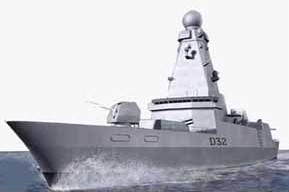
This is a strategic win for RSL as it will grow the company's share of the UK naval market and will provide Raytheon with the opportunity to establish a world benchmark for Navigation Systems for the next generation of Navy ships. Peter McKee, managing director of RSL, said: "Raytheon in the UK has had a long association with the Royal Navy, supplying and supporting weapon systems, identification systems and navigation systems. This relationship will now be reinforced by supplying the Integrated Navigation System for the Type 45." He added: "This will be an important contract for Raytheon's European businesses and it will draw on our indigenous marine capabilities as well as capitalising on technologies developed by our sister business units in the US." The first Type 45 is due to enter service in 2007.
Tuesday, March 13, 2001
PC News
Waterloo: Napoleon's Last Battle Goes Gold.
Strategy First Inc. and Breakaway Games are pleased to announce that Waterloo: Napoleon's Last Battle, developed by Breakaway Games has gone gold. Based on the Sid Meier's Gettysburg engine, Waterloo brings back to life Napoleon's most memorable battle. With over 25 historical scenarios, the game features unique Orders of Battle, famous troop types, including dragoons, hussars, cuirassiers, as well as the Old and Young guard, and famous landmarks like the Hougoumont complex, La Haye Sainte and Plancenoit Church. The game also features over 60 historically accurate and hand painted uniforms that reflect the grandeur of the period. Scheduled for release at the end of March, the game will be distributed exclusively throughout North America by Infogrames.
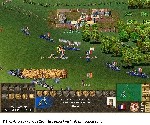
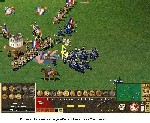
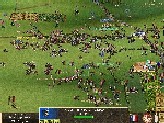
Military News
Six Killed in Kuwait Training Accident
Six people were killed and at least five were injured March 12 when a Navy jet accidentally dropped "explosive ordnance" on a group watching a training exercise in Kuwait, military officials said. Five of those killed were U.S. service members. U.S. Central Command officials at MacDill Air Force Base, Fla., released no further information as to their identity or service. The sixth observer killed was a member of the New Zealand armed forces.
Three U.S. service members remain hospitalized with "non-life-threatening injuries." One was transferred to Landstuhl Regional Medical Center in Germany, and two remain in a military hospital in Kuwait, Army Lt. Col. Rick Thomas, a CENTCOM spokesman, said.
The accident occurred at 8 p.m. Kuwaiti time (11 a.m. Eastern time) during a joint Kuwaiti-U.S. air exercise near the Al Udairi firing range, about 30 miles south of Iraq.
CENTCOM officials have not confirmed press reports that the weapon in question was a 500-pound bomb. They do confirm the weapon was dropped by a U.S. Navy FA-18 Hornet from the aircraft carrier USS Harry S. Truman, now on a six-month tour in the Gulf.
DoD officials have not released any information as to the cause of the accident. Thomas said members of an accident investigation board, led by CENTCOM officials, will arrive in Kuwait "this week."
Defense Secretary Donald Rumsfeld said in statement that DoD officials will "work hard to take care of the families involved, and to find out how such an accident could occur."
After hearing of the accident while visiting the Florida Panhandle, President George W. Bush extended his sympathies to the families involved. "I'm reminded today of how dangerous service can be," he said, speaking to a March 12 meeting of the Panama City Area Joint Rotary Club and Chamber of Commerce. Bush then asked for a moment of silence.
Investigators Release Misawa F-16s Midair Collision Results.
U.S. Air Force investigators determined pilot error was the cause of a midair collision between two F-16 Fighting Falcons over the Sea of Japan Nov. 13. The collision occurred 32 nautical miles west of Matsumae, Hokkaido, Japan. The mishap aircraft were No. 1 and 2, respectively, in a four-ship dissimilar air combat tactics exercise.
Early in the mission, the flight initiated a standard air-to-air gravity awareness maneuver to heighten aircrew awareness of the increased G-forces that would be experienced during a mission. The maneuver also provided an opportunity to test the aircraft equipment designed to prevent G-induced loss of consciousness and practice the anti-G straining maneuver. Air Force instructions require aircrews to fly a G-awareness exercise anytime they plan or are likely to experience more than 5-G's during a mission.
Starting the maneuver four abreast with roughly 6,000 feet separation between aircraft, the flight initiated an in-place 90-degree right turn. When the flight rolled out of the turn the four were then in trail with each other -- No. 4 in the lead, then No. 3, then mishap pilot 1, and mishap pilot 2 last. Mishap pilot 1 continued the G-awareness maneuver by next directing an in-place 180 degree left turn. This turn was initiated from a visual, in trail formation. During this turn the aircraft of mishap pilot 1 and mishap pilot 2 collided at about 12,900 feet altitude.
Both aircraft sustained major damage and were uncontrollable. No one in the flight saw mishap pilot 1 eject from his disabled aircraft before it crashed. Mishap pilot 2 successfully ejected and parachuted injury-free into the Sea of Japan, where he was rescued by a Japan air self-defense forces UH-60 helicopter.
U.S. forces, Japan self-defense forces, and the Japan Maritime Safety Agency conducted search and rescue efforts for two days before mishap pilot 1 was declared lost at sea and presumed dead. Based on evidence obtained during the investigation, the Accident Investigation Board president's opinion is that the cause of the mishap was pilot 1's failure to see pilot 2 during the 180-degree turn and avoid a collision, as it was his responsibility to do.
Investigators also indicated there is substantial evidence that mishap pilot 2 misperceived his distance behind mishap pilot 1 before the second turn, causing a flight path conflict that mishap pilot 1 may not have expected and thereby significantly contributed to the mishap.
The investigators also found substantial evidence that flying the 180-degree G-awareness turn from a visual, in-trail formation did not provide adequate collision avoidance opportunity for either pilot.
Navy JSF Completes Historic Flight-Test Program.
The Lockheed Martin Joint Strike Fighter (JSF) X-35C, flying at a rate of up to six missions per day, completed its flight-test program with all objectives achieved on Sunday, March 11, at Naval Air Station Patuxent River, Md. The airplane logged a total of 73 flights and 58 hours aloft.
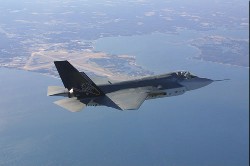
"This is a milestone in what is clearly one of the most successful flight-test programs in aviation history," said Tom Burbage, executive vice president and general manager of the Lockheed Martin JSF program. "Our team kept the X-35C’s design common with our other JSF variants, but gave this plane some unique features to optimize it for carrier operations. The outcome, as we’ve shown in flight testing, is a magnificent carrier strike aircraft that for the first time will bring the element of stealth technology to the Navy."
The X-35C carrier variant (CV), designed to demonstrate carrier-suitable flying qualities for the United States Navy, first flew on Dec. 16, 2000. On Jan. 31, it became the second Lockheed Martin JSF demonstrator to fly supersonic, and on Feb. 10 it flew from coast to coast, becoming the first "X" plane in history to complete a transcontinental flight. Eight pilots have flown the aircraft.
"I could tell from the first flight that the X-35C was going to be representative of a very good carrier plane. When we began aggressive FCLPs (field carrier landing practices) the aircraft really showed off its superb responsiveness and controllability," said test pilot Joe Sweeney, a former U.S. Navy carrier pilot. "We deliberately forced errors in the glide slope, speed and line-up, challenging the plane’s ability to respond, and it performed exceedingly well. I can't say enough about this engineering and flight test team."
During an FCLP, the pilot shoots an approach exactly as he would on an aircraft carrier. The X-35C, which features a larger wing and control surfaces than the other JSF variants, completed 250 FCLPs during testing.
"We put the airplane through a battery of practice carrier approaches in a very short time. The airplane's performance was outstanding," said Lt. Cmdr. Greg Fenton, a U.S. Navy test pilot assigned to the X-35. "Several of Strike's Landing Signal Officers (LSOs) got an opportunity to observe the airplane ‘on the ball’, and were quite impressed with its ability to handle intentional deviations during the practice carrier landings."
The X-35C becomes the second Lockheed Martin JSF variant to successfully complete a flight-test program. The JSF X-35A conventional takeoff and landing (CTOL) variant finished its testing on Nov. 22, 2000, establishing a host of new flight-test records. Both aircraft completed all test points required by the government, as well as additional Lockheed Martin JSF team objectives designed to reduce technical risk.
Monday, March 12, 2001
PC News
New Steel Beast Scenario and Mod Forum.
The Official Steel Beasts Fansite has introduced the Scenario and Mod Forum. Users can now POST any new missions or mods straight to the Scenario and Mod Upload Forum! Right now users are limited to 20 total files that they may have up at one time - and each file has to come inat no more than 2 MBs. For more details and to check out all the new Scenarios, go to: Scenario and Mod Forum
Aces High Version 1.06 Released.
HiTech Creations has announced that Aces High Version 1.06 and Patch 1 is now available through the autoupdater or their download page at: Hi Tech Creations
Version 1.06 includes:
Offline, H2H Host, and CM's
CM's
Hangar
Misc.
Version 1.06 Patch 1 Fixes:
The Project Vision Web Site Launced.
Project Vision is a development team which right now is building the first totally new aircraft for Falcon 4.0 - The Dassault Mirage 2000EGM. The M2K project brings together flight simulation enthusiasts from around the world to create the best in realism and authenticity. Currently Project Vision plans are to introduce totally new areas to the M2K, unseen before in other aircraft. The Mirage 2000 will have its own painstakingly accurate symbology / systems, as well as the cockpit, its functions and minor details important to "the immersion factor". Check it out at:
Project Vision
Military News
F-18 Accidentally Drops Bomb In Kuwait.
The U.S. Pentagon said 5 people were killed and at least five people were wounded, including two Kuwaitis. All were watching a joint U.S.-Kuwaiti exercise on a bombing range in northwestern Kuwait at the time of the accident, U.S. officials said. The accident occurred about 7:30 p.m. (11:30 a.m. EST) when a U.S. Navy F/A-18 Hornet from the aircraft carrier USS Harry S. Truman dropped a 500-pound bomb during the training exercise. U.S. and Kuwaiti forces routinely fly joint training missions at the Udairi training ground, about 31 miles (50 kilometers) south of the Iraqi border.
Boeing Adds BAE Systems Australia To Apache Air 87 Team.
BAE Systems Australia has joined The Boeing Company's team of defense contractors that is offering the AH-64D Apache multi-role combat helicopter for the Australian Army's armed reconnaissance helicopter program, known as Air 87. The AH-64D Apache offers Australia a low-risk, cost-effective and off-the-shelf solution to its defense needs. Australia Team Apache, as the Boeing-led team is known, brings together a wide range of the world's best defense contractors, including several aerospace leaders in Australia.
BAE Systems' role, which is being defined, could include support by BAE Systems in the development and production of a wide range of electronic equipment for the AH-64D Apache offered to Australia. Support for numerous systems and subsystems aboard the AH-64D, including electro-optical systems and electronic warfare self-protection, is in review. The teaming agreement also could include future maintenance support of such systems. BAE Systems' ultimate role will be defined in the next few months, according to officials at both companies.
The Apache Longbow, produced by Boeing in Mesa, Ariz., is the newest version of the combat-proven AH-64A Apache. It is a candidate to fulfill the attack helicopter and reconnaissance requirements of numerous armed forces. Defense forces worldwide have selected the next-generation AH-64D Apache because of its multi-mission effectiveness and its peacetime cost of ownership.
Navy To Commission Aegis Destroyer Winston S. Churchill.
The Department of the Navy commissioned its newest guided missile destroyer Winston S. Churchill (DDG 81) Saturday during a ceremony at Town Point Park, Norfolk, Va. Winston S. Churchill is the fifth American warship to be named in honor of an Englishman and will be the only one in active service named after a foreign dignitary.
The ship is named in honor of Sir Winston Spencer Churchill (1874-1965), best known for his courageous leadership as British prime minister during World War II. He was a formidable political thinker, soldier, pilot, farmer, bricklayer, painter and skilled orator. When he retired from the House of Commons in 1964, Churchill had spent more than six decades in public life, a career that spanned the period from the last great British cavalry charge to the nuclear age.
Winston S. Churchill is the 31st ship of the Arleigh Burke class and the 18th of the class to be built by Bath Iron Works. These highly-capable multi-mission ships can conduct a variety of operations, from peacetime presence and crisis management to sea control and power projection, in support of the National Military Strategy.
The mission of Winston S. Churchill is to conduct sustained combat operations at sea. The ship is capable of fighting air, surface, and subsurface battles simultaneously. It is equipped with the AN/SPY-1D phased array radar, the most powerful air search radar in Navy's inventory. The ship contains myriad offensive and defensive weapons designed to support maritime defense needs well into the 21st century.
The new destroyer boasts of several unique features. It is the only U.S. Navy ship to have a Royal Navy officer assigned to ship's company. The British officer, Lt. Angus Essenhigh RN, will serve as the ship's navigator during his tour of duty. Also the ship has the first installation of the Navy's most advanced gun - Mk 45 Mod 4 - a 5"/62 caliber gun designed to shoot an extended range guided munition with incredible accuracy at targets nearly 60 miles away.
Cmdr. Michael T. Franken, a native of Sioux City, Iowa, is the commanding officer of Winston S. Churchill, commanding a crew of 24 officers and 326 enlisted personnel. The ship will be homeported in Norfolk, Va., as an element of the U.S. Atlantic Fleet. The ship is 513 feet in length, is 148 feet in height, has a draft of 33 feet, a beam of 66 feet and displaces approximately 8,580 tons when fully loaded. Four gas-turbine engines power the ship to speeds in excess of 30 knots.
Click Here for Printer Version
© 1997 - 2000 COMBATSIM.COM, Inc. All Rights Reserved.
